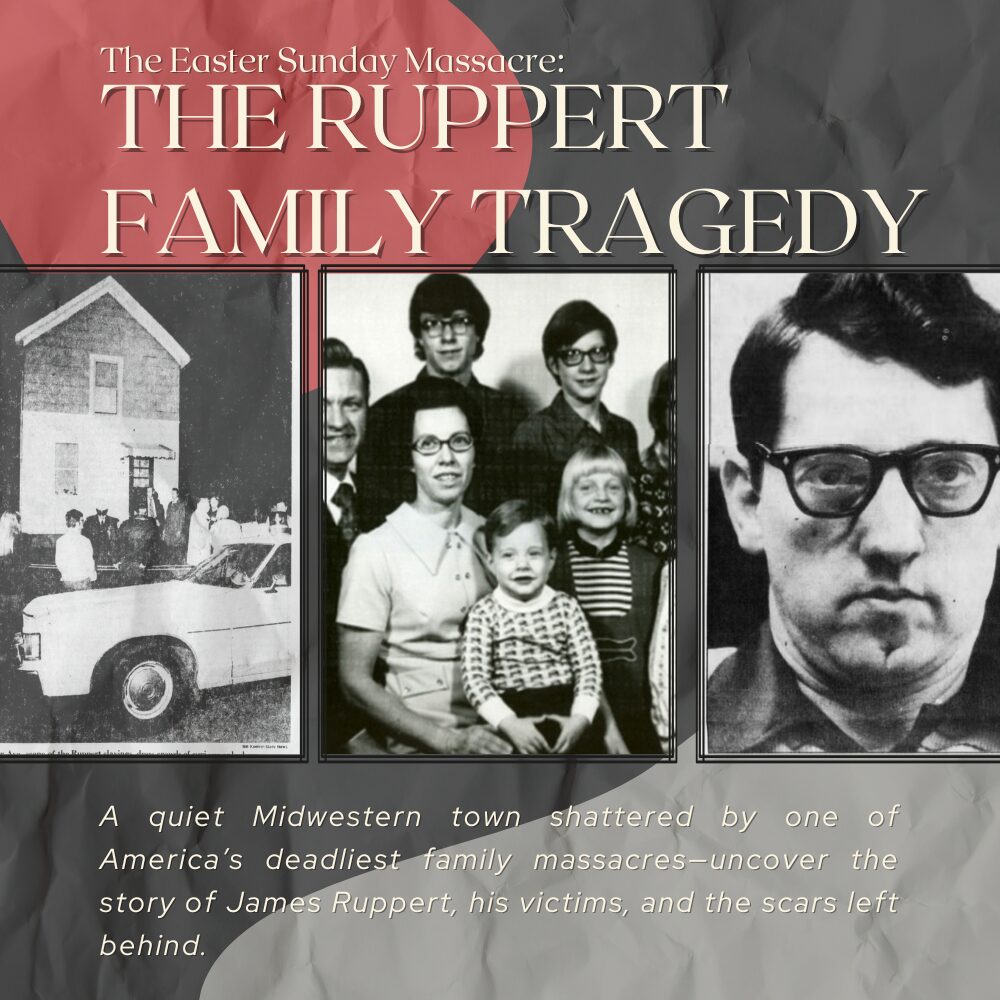A Box in the Cornfield
October 8th, 1976, started like any other normal day for the Skoog family, who lived near the small town of Otterbein, Indiana. Norman Skoog and his family ran a farm, tending to acres of corn ready for harvest. While his 16-year-old son, Curtis, mowed the grass, Norman was out in the fields with his combine. Around 5:30 p.m., he spotted a cardboard box lying in the corn, about nine rows deep. At first, he assumed one of his kids had left it there, but when he tried to move it, he realized it was too heavy to lift. That box held a mystery that would haunt Benton County for decades—the case of Benton County Jane Doe.

When they got it back to the house, they noticed a strange odor wafting from the box, the sickly sweet scent of cheap woman’s perfume. It was as if the box had been drenched in the perfume. Police described the box as one that was typically used by moving or storage companies. It was approximately 3’x2’x1′ with “wardrobe bottom” stamped at one end and written on another part of the box was “hall closet.”
A Frightening Discovery
Gray furnace tape sealed the box shut, and a clothesline secured it. As he stared at the sealed box, a sinking feeling set in. Something was very wrong. Curious as to what was inside, Norman cut a piece of the tape and opened up a small corner of the box. All he could see was an almost empty perfume bottle and something wrapped in heavy plastic. He told Curtis to put the bottle back in the box, and realizing that something was not right, Norman Skoog alerted the sheriff’s office.
Benton County Jane Doe
When authorities arrived and opened the box, they found an object wrapped in layers of heavy plastic, the kind used to protect carpeting in busy areas. Masking tape secured the plastic in place. Upon unwrapping the plastic, it quickly became clear that the killer had used perfume to try and mask the unmistakable smell of decomposition. As they unwrapped the gruesome package, they found a woman’s body, placed in the fetal position and bound by more rope. The woman wore light green pants with a matching light green and tan knit shirt. The clothing was in relatively good condition with no rips or worn areas and surprisingly few stains, considering the pathologist would later determine the woman had been dead for approximately 7 to 10 days. She was not wearing shoes and had no jewelry on her body.
The killer wrapped the woman’s head in paper towels, a “smaller than average white cloth towel,” and two small light-colored trashcan liners. She wore no makeup, kept her nails trimmed and neat, and had noticeable callouses on her hands. She appeared to be in her late 50s or early 60s with light brown or brownish-gray hair and brown eyes. Although there was very little for the police to go off of in the hopes of making an identification, the woman’s body did offer a couple of specific clues.
A recent mastectomy had left a scar on her right side. Dental work showed signs of past treatment, but she needed more. A vertical scar stretched from her sternum to her stomach. Investigators took her fingerprints and sent them to the FBI, but no matches came back. No records linked her to an arrest, military service, civil employment, or immigration. A single gunshot wound to the back of her head had ended her life.
Investigators soon realized something even more unsettling, no one had reported this woman missing.
No One Came Forward
Investigators surely expected someone to come forward looking for their missing mother, sister, wife, or aunt. They got a couple of calls from the surrounding area, but the woman in the box didn’t match the description given. The newspapers published a sketch of the woman’s face taken from police photos hoping it would cause someone to recognize her and come forward but to no avail. Police believed that perhaps she was a cleaning lady due to the callouses on her hands. Police theorized that she was in the wrong place at the wrong time or witnessed something she was never meant to see. Perhaps there was even Mafia involvement.

Investigators turned their focus to the box that contained the woman’s body. A company based in Melrose, Illinois, manufactured the box and distributed it to moving and storage companies in Indiana (Gary and Hammond), the Chicago area, southern Michigan, and parts of Wisconsin. Not exactly a small area of distribution. Police, however, believed the woman was most likely from Chicago. This wasn’t the type of crime to happen in this rural section of Benton County, Indiana.
They next focused on just how the box ended up in the “back 40” of Norman Skoog’s farm. The Skoog farm was not close to any major roads. Located six miles north of U.S. 52, this area of Benton County was only reached by a series of twists and turns down small rural roads.

Norman doubted that anyone could have placed the box nine rows into the cornfield without breaking stalks. Police also determined that someone left the box there just hours before Norman found it. The box was dry when found, despite rain the night before. After talking to people who lived near the Skoog farm they concluded that no one saw or heard a car in the area, but they did report hearing and seeing something unusual.
A Helicopter in the Cornfields
Three witnesses saw and heard a helicopter near the Skoog farm on the morning Norman Skoog discovered the box. Not only was seeing a helicopter highly unusual for the area, but this was also a costly type of helicopter: a white and gold Bell JetRanger.

In 1976 the average cost of a JetRanger was $160,000, which is equivalent to approximately $760,000 today. Not exactly a common thing to see in the rural farmland of Benton County, Indiana. At the time, police stated that only major corporations or the very wealthy could have owned a helicopter of that type.
Witnesses reported that the helicopter approached from the northeast, swung toward the southwest, then lowered and hovered over the Skoog crops. Moments later, it lifted back up, flew west, and quickly vanished into the northwest.
Forgotten, Then Exhumed
On October 9th, 1976, the Unknown Woman was given a pauper’s burial in Fowler Cemetery. Without a headstone, she lay forgotten for 43 years.

For decades, the case remained cold. Then, in June 2019, the Benton County Coroner received a search warrant and order to exhume the Unknown Woman’s body. A team from the Human Identification Center at the University of Indianapolis carefully excavated the grave, finding the simple wooden coffin had almost entirely disintegrated. They quickly found her remains inside a body bag. Investigators took her to the Tippecanoe County morgue, then transferred her to the University of Indiana to begin the investigation. Unfortunately, this case never gained much attention, and officials have not made any new findings public.
Will This Mystery Ever Be Solved?
More than one person had to be involved in leaving her body at that location. Whether they transported her by car or helicopter, the weight made it impossible for one person to move alone. I believe someone out there still knows the truth. Hopefully, investigators will at least uncover her identity so she can finally be buried under her real name. With more awareness and advancing technology, police may also find the person responsible for her murder.



